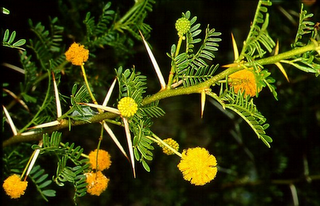My Acacia Karroo (Soetdoring - Vachellia karoo) after the Springs rains October 2009
- Camera : FujiFinepix 2800Zoom
- Camera : FujiFinepix 2800Zoom
My thorn trees (Acacia) are just coming into bloom and for those that suffer from hay-fever, this is really a bad time of the year, especially if we haven't had much rain. Spring started off very dry, and we have only had some decent rain late in November this year.
During Winter I'm able to prune the tree's low-hanging branches a bit and I just love keeping some of the branches with the HUGE thorns for display around the house - they become quite a conversation piece!
This is one of South Africa's most beautiful and useful trees. It is integrally part of our country's history having been used for everything from raft-making to sewing needles and fencing for the houses of the royal Zulu women. The thorns were even used by early naturalists to pin the insects they collected! It is very widespread throughout southern Africa and there are different forms in some places, which can be confusing. Acacia karroo may be found from the Western Cape through to Zambia and Angola. In tropical Africa it is replaced by Acacia seyal. The name Acacia is derived from Greek "akis" a point or barb. Karroo is one of the old spellings of karoo which cannot be corrected because of the laws governing botanical nomenclature (giving of names).
The sweet thorn makes a beautiful garden specimen. The bright yellow flowers look very striking against the dark green foliage. The rough, dark brown bark is also most attractive. The flowers are sweetly scented and are renowned for attracting insects which are essential to any bird garden. Birds also like to make nests in thorn trees as the thorns offer them some protection from predators. These thorns can grow up to 6" (15cm) long and if they are very thick, it's an indication of an abundance of water. Caterpillars of 10 species of butterflies are dependant on the tree for survival. These include, the club-tailed charaxes (Charaxes zoolina zoolina) and the topaz-spotted blue (Azanus jesous). In cold and dry areas like where I live, the tree is deciduous.
Regions where the Acacia Karroo can be found - I can be found approx. where the red dot is at the bottom of Southern Africa. (Click on pic to enlarge)
Vachellia karoo - Acacia 'karroo' flowers" Watercolour sketch - Maree©
Acacia karroo also known as the Sweet Thorn (Vachellia karoo), is a species of Acacia, and the tree is especially useful as forage and fodder for domestic and wild animals. Apparently, there is no risk of poisoning from it. Goats seem to like A. karoo better than cattle. The flowers appear in early summer in a mass of yellow pompons and make a very good source of forage for honey bees; honey from it has a pleasant taste.
An edible gum seeps from cracks in the tree's bark. The gum can be used to manufacture candy and it used to have economic importance as "Cape Gum". In dry areas, the tree's presence is a sign of water, both above and underground.
It is a tree of open woodland and wooded grassland. It grows to its greatest size when rainfall of 800-900mm is received but can grow and even thrive in very dry conditions such as the Karroo region of western South Africa. The requirement here is for deep soils that allow its roots to spread. Everywhere in its range, however, the tree is easily recognised by its distinctive long white paired thorns and coffee coloured bark, both of which are very attractive. In the tropics it shows little variation but at the southern end of its range it becomes more variable in appearance.
Common names in various languages include Karoo Thorn, Doringboom, Cape Gum, Cassie, Piquants Blancs, Cassie Piquants Blancs, Cockspur Thorn, Deo-Babool, Doorn Boom, Kaludai, Kikar, Mormati, Pahari Kikar, and Udai Vel
.















